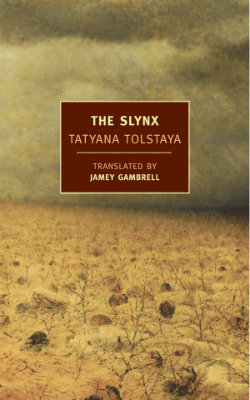 Well, The Slynx certainly was…interesting. I’m not quite sure what to think of it, though I liked it. It’s been on my TBR list for a year or two (I even included it in my TBR Pile Challenge!), though I’m not sure how it got there. I’m pretty sure it has to do with Skylark and NYRB Classics. Anyway. The Slynx.
Well, The Slynx certainly was…interesting. I’m not quite sure what to think of it, though I liked it. It’s been on my TBR list for a year or two (I even included it in my TBR Pile Challenge!), though I’m not sure how it got there. I’m pretty sure it has to do with Skylark and NYRB Classics. Anyway. The Slynx.
It’s a dystopian novel about a post-“Blast” civilization. An atomic bomb blew up something like two hundred years before, and the few survivors banded together. There’s a little town, but most of the survivors have died. Some are a few hundred years old. Most of the citizens are relatively young, and they’ve lost most technology and the ability to think. The vast majority of people have Consequences, products of radioactivity. Benedikt, the protagonist, has (well, had) a tail, his wife and her family have claws that grind the floor, and one of his coworkers has an ever-increasing number of cockscombs growing all over her body. The poor (including, at first, Benedikt) eat mice and whatever they can find that isn’t known to poison you. They all live in horrible conditions. Benedikt’s job is to copy works of literature, whether good or bad, onto scrolls. Most of them know how to read, but language has changed a lot over that long period. Benedikt marries well and is introduced to a small library. He is entranced and reads through all the books within a couple of years. He can’t get enough and becomes an addict. His whole life revolves around acquiring and reading books, and increasingly terrible things begin to happen as a consequence.
The Slynx is a strange book. It’s postmodern and Russian, written sometime in the 1980s. The name comes from a mythical creature in the book:
[box type=”shadow”]The town of Fyodor-Kuzmichsk spreads out over seven hills. Around the town are boundless fields, unknown lands. To the north are deep forests, full of storm-felled trees, the limbs so twisted you can’t get through, prickly bushes catch at your britches, branches pull off your head. Old people say the Slynx lives in those forests. The Slynx sits on dark branches and howls a wild, sad howl – eeeeennxx, eeeeennxx, eeenx-a-leeeeeennnxx! – but no one ever sees it. If you wander into the forest it jumps on your neck from behind: hop! It grabs your spine in its teeth – crunch – and picks out the big vein with its claw and breaks it. All the reason runs right out of you. If you come back, you’re never the same again, your eyes are different, and you don’t ever know where you’re headed, like when people walk in their sleep under the moon, their arms outstretched, their fingers fluttering: they’re asleep, but they’re standing on their own two feet. People will find you and take you inside, and sometimes, for fun, they’ll set an empty plate in front of you, stick a spoon in your hand, and say “Eat.” And you sit there like you’re eating from an empty plate, you scrape and scrape and put the spoon in your mouth and chew, and then you wipe your dish with a piece of bread, but there’s no bread in your hand. Your kinfolk are rolling on the floor with laughter. You can’t do for yourself, not even take a leak, someone has to show you each time. If your missus or mother feels sorry for you, she takes you to the outhouse, but if there’s no one to watch after you, you’re a goner, your bladder will burst, and you’ll just die. (5)[/box]
That paragraph really is The Slynx in a nutshell. It’s about how people in this new society treat one another and the tactics they use to keep each other in line. I thought I was getting some kind of variation of 1984 or We, but it’s really nothing like either of them. It seems more similar to the Koyaanisqatsi film series than anything I’ve read.
Which means that you should get a copy and read it. It’s not the usual dystopian rehash. That’s what I like about this NYRB Classics series: I haven’t read anything that wasn’t absolutely amazing. I guess The Slynx hasn’t gotten the same kind of attention that We has because it’s so weird. But that’s what makes it interesting and worthwhile.